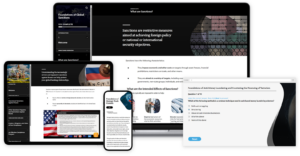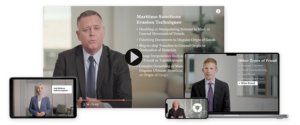A Necessary Shift in Mindset
Rethinking Compliance Training for Stronger Risk Management
📅 July 10, 2025
Rethinking Compliance Training for Stronger Risk Management
📅 July 10, 2025
For years, compliance training has been treated as a regulatory checkbox—an annual obligation completed through mandatory modules and online courses. But as risks grow more complex and the pressure from regulators intensifies, this approach is showing serious cracks. We’re at a point where checking the box isn’t enough. Compliance training needs to evolve from routine exercise into a meaningful part of how we manage risk—because the threats we face today don’t wait for the annual refresher.
Training must serve a bigger purpose: managing risk in real time, across the institution. That shift—from cost center to strategic asset—requires a fundamental rethink of how compliance training is designed, delivered, and measured.
Transforming compliance training from a “necessary expense” to a true risk management tool doesn’t happen overnight. But when financial institutions take a smarter, more strategic approach, the benefits ripple throughout the organization.
The real purpose of compliance training isn’t just to show regulators that something was completed—it’s to make sure people actually know what to do when it counts.
That means equipping teams to recognize red flags, ask the right questions, and act with confidence in moments that matter. Whether it’s a customer onboarding issue, an unusual transaction pattern, or a potential sanctions exposure, frontline staff need to be able to connect the dots and escalate appropriately.
When training is grounded in real scenarios—not just policy language—it becomes something practical, not theoretical. And that’s when it starts to work.
It’s easy to think of compliance training as a sunk cost. But institutions that invest in better training see clear, measurable returns:
These aren’t abstract benefits—they directly support regulatory expectations, customer trust, and operational efficiency.
Training does more than transfer knowledge—it helps shape the culture of an organization. When it’s consistent, thoughtful, and woven into the everyday employee experience, it sends a clear message: compliance isn’t just the job of the legal or risk team—it’s something we all own.
Culture is what guides behavior when no one’s watching. And in financial services, where employees often face fast-moving decisions with serious consequences, that invisible guide matters—a lot.
That’s why the how of training is just as important as the what. When it’s interactive, grounded in real-life scenarios, and leaves space for reflection—not just rules to memorize—it helps people truly understand what’s expected of them. Over time, that builds something deeper: a culture where integrity is the norm, and doing the right thing feels like second nature.
Regulators aren’t just looking to see whether training happened anymore—they want to know if it actually works. Attendance logs and course completion rates aren’t enough on their own. What regulators really want to see is that training is meaningful and effective.
That means showing that your programs are:
If institutions can’t demonstrate this, they may face tougher scrutiny, fines, or pressure to overhaul their programs entirely.
On the flip side, those that take training seriously—who invest in thoughtful, proactive learning—are in a much better position to stay ahead of the curve. Whether it’s digital asset abuse, fraud through third-party vendors, or rapidly shifting sanctions rules, they’re ready for what’s coming because their people are prepared.
The most resilient financial institutions aren’t just meeting training requirements—they’re using training as a core part of their risk management strategy.
When it’s built with intention, training becomes a kind of strategic infrastructure. It helps teams spot problems early, reinforces what the organization stands for, and gives people the confidence to make the right call—even under pressure.
That shift in thinking—from treating training as an expense to seeing it as a real risk control—is long overdue.
But the institutions that make that shift? They’ll not only avoid costly mistakes—they’ll build stronger, more agile cultures that are ready for whatever comes next.

Explore our suite of compliance e-learning courses covering an array of financial crime compliance topics. All courses are designed to maximize retention of relevant knowledge and are available for customization.

An on-demand library containing 100 videos designed for today’s risk environment, this expert-led training program makes complex topics clear, practical, and engaging.










 Cartels & Crypto
Cartels & CryptoThis site uses cookies. By continuing to browse the site, you are agreeing to our use of cookies.
Accept settingsHide notification onlySettingsWe may request cookies to be set on your device. We use cookies to let us know when you visit our websites, how you interact with us, to enrich your user experience, and to customize your relationship with our website.
Click on the different category headings to find out more. You can also change some of your preferences. Note that blocking some types of cookies may impact your experience on our websites and the services we are able to offer.
These cookies are strictly necessary to provide you with services available through our website and to use some of its features.
Because these cookies are strictly necessary to deliver the website, refusing them will have impact how our site functions. You always can block or delete cookies by changing your browser settings and force blocking all cookies on this website. But this will always prompt you to accept/refuse cookies when revisiting our site.
We fully respect if you want to refuse cookies but to avoid asking you again and again kindly allow us to store a cookie for that. You are free to opt out any time or opt in for other cookies to get a better experience. If you refuse cookies we will remove all set cookies in our domain.
We provide you with a list of stored cookies on your computer in our domain so you can check what we stored. Due to security reasons we are not able to show or modify cookies from other domains. You can check these in your browser security settings.
These cookies collect information that is used either in aggregate form to help us understand how our website is being used or how effective our marketing campaigns are, or to help us customize our website and application for you in order to enhance your experience.
If you do not want that we track your visit to our site you can disable tracking in your browser here:
We also use different external services like Google Webfonts, Google Maps, and external Video providers. Since these providers may collect personal data like your IP address we allow you to block them here. Please be aware that this might heavily reduce the functionality and appearance of our site. Changes will take effect once you reload the page.
Google Webfont Settings:
Google Map Settings:
Google reCaptcha Settings:
Vimeo and Youtube video embeds:
You can read about our cookies and privacy settings in detail on our Privacy Policy Page.
Privacy Policy